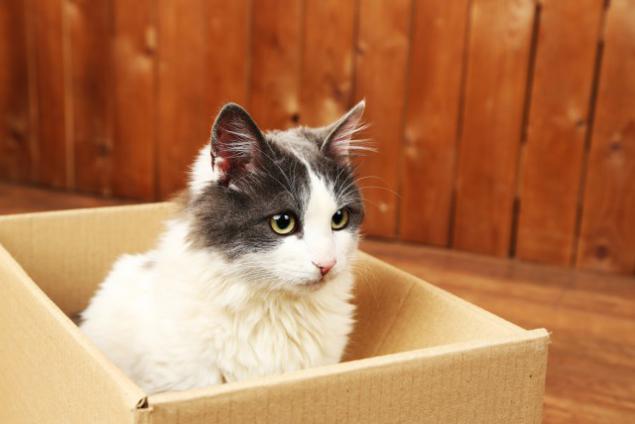The mystery of the century: why cats are so fond of the box?
 Bashny.Net
Bashny.Net

So what do we do with a strange force of gravity empty packages acting on our pets? Like many very strange things that cats do, science is not yet fully unravel this mystery cat. However, it can be argued that the box will have the instinct of predators: cats ambush, boxes serve them shelter during a hunt and provide protection during the retreat. But this is not the only explanation.
Experts in the field of biology and veterinary medicine have found some interesting explanations. And when you meet them, you will immediately realize that cats just love to box, and really need them.
Crate usamiKak know, the cat is extremely difficult to understand. Usually these animals are difficult to study. However, there is a considerable amount of research feline behavior, conducted in laboratory cats. These studies, many of which are aimed at improving animal habitats, conducted over 50 years, and have come to one conclusion is absolutely clear: your furry friend in confined spaces feels comfortable and safe. < In stressful situations box or something similar to it, it can have a huge impact on the behavior and the physiology of the cat.
Veterinarian Claudia Vink of University of Utrecht in the Netherlands - one of the researchers studying stress in the cat shelters. Working with domestic cats in an animal shelter, Vink gave one group of newly arrived cats access to secluded boxes and other groups deprived of any shelter. As a result, it revealed a significant difference in the level of stress in cats with shelter and cats deprived of it. Animals from the first group to get used to new surroundings quickly, were much less stressed in the initial stages of life in the shelter, and were easier to connect with people.
This makes sense when you consider that the first reaction of almost all the cats in a stressful situation - run and hide. "Lurking - type of behavioral strategies to help animals cope with environmental change and stress", - says Wines.
This applies to both wild and domestic cats to. Only instead of hiding at the top of the tree in a hole or cave, your pet can find refuge in a shoe box.
Box (anti-) social barerTakzhe important to note that cats really do not know how to deal with conflict situations. Quote from the book by Dennis Turner and Patrick Bateson
«Domestic Cat: The Biology of their behavior": "Cats do not develop a strategy to resolve conflicts as do more gregarious and sociable species. Therefore, they may try to bypass hostile collision ».
blockquote> That is instead of decisive action just cats tend to hide from problems. Box in this sense, can be a safe zone, a place where the sources of anxiety, hostility and unwanted attention just disappear.
The problem is that such an explanation does mark the box "heavy" nature of the cat and its exposure to stress. However, I do not know about you, but I Maru the cat out of the video presented below, does not seem tense or frightened.
The principle of «If it fits, I sits» («if placed - climbed") Careful observers will note that in addition to boxes many cats choose other strange destinations. Some curl up in the sink. Others prefer to shoes, bowls, bags, coffee mugs and other small confined spaces.
This brings us to the next answer to the question of why your cat is very like little boxes (and other seemingly uncomfortable seats): this is cold.

According to the survey of 2006, the National Research Centre, thermoneutral zone for a domestic cat is 30 - 36 degrees Celsius. This is the temperature range in which the cat is comfortable and does not need to generate additional heat to keep warm, or to spend metabolic energy to cool. This range of our above 10 degrees. So often you can see a cat stretched out on the hot asphalt in the middle of a hot summer day and enjoy the sunshine.
It also explains why many cats love to curl up in tiny cardboard boxes and other strange places. Corrugated cardboard - an excellent insulator and helps the cat to retain body heat.
The same study showed that the temperature of residential areas most cats is about 22 degrees Celsius, or 14 degrees lower than their thermoneutral temperature.
So, the answer is found: the box - a thermal insulation, relieves stress zone; places where cats can hide, relax, sleep and occasionally ambush huge, unpredictable monkeys, with whom they live.
via www.wired.com/2015/02/whats-up-with-cats-and-boxes/#slide-id-1720771
Tags
See also
Why we love to remember the "good old days"
Why cats love to sleep close to their owners?
Why cats are so fond of boxes
To understand the universe: what is the quantum of and why its so fond of psychics
Why cats bite only those who suffer from depression?
Why cats see in the dark
Why are we so often do NOT UNDERSTAND each other
Trams rattle so Why?
Why do we love to complicate things
What I mean: Steven Pinker — about why we so often say hints

















